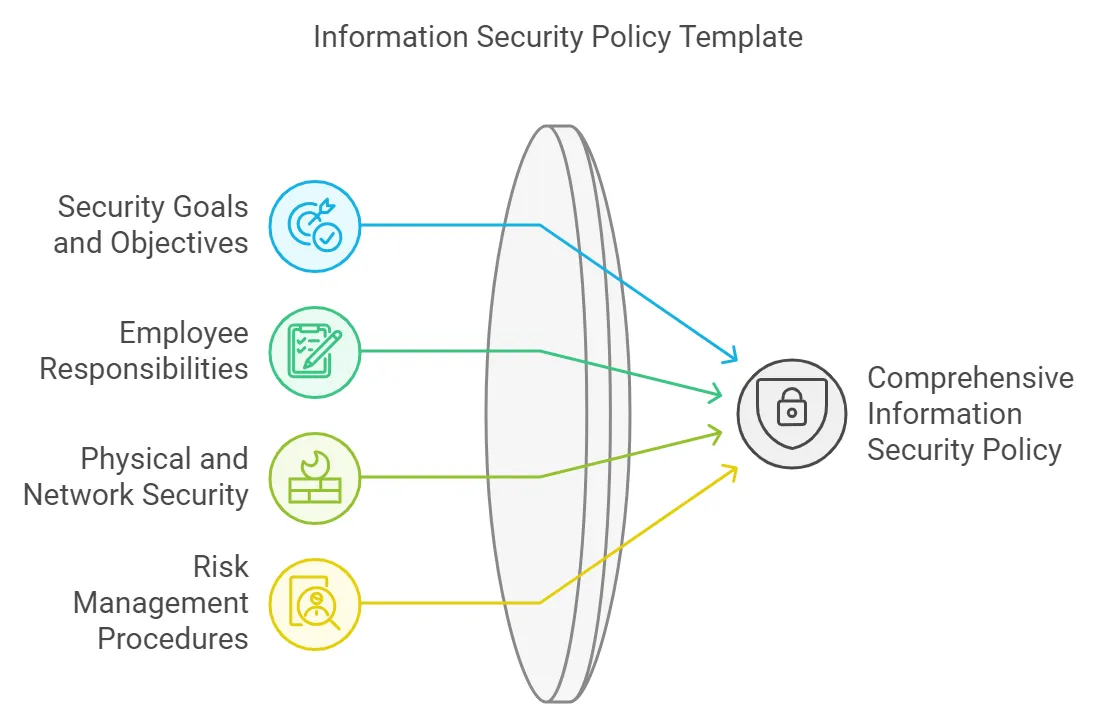
Cyber attacks and data breaches are at an all-time high, threatening businesses of all sizes.
In fact, 2023 saw a 72% increase in data breaches since 2021, which held the previous all-time record. If you’re not prepared, your business could be next.
As Chris Power, CEO of Power Consulting, says, “An information security policy provides the foundation for an effective cyber strategy, which every company needs.”
In this blog, we’ll explore what is information security policy, why it matters, and how to implement one that truly protects your assets.
Understanding Information Security Policy
An information security policy is a formal document outlining how an organization manages and protects its sensitive information. It’s the cornerstone of an organization’s data protection strategy, ensuring all employees follow uniform guidelines to keep information safe. It establishes protocols to safeguard against threats like cyber attacks, insider misuse, and data leaks.
Protect Your Business, Stay Alert & Act Now!
Don’t risk your company’s sensitive data—get ahead of cyber threats with an ironclad information security strategy today.
These policies typically cover a wide range of aspects, such as acceptable use, password management, access control, and incident response.
Power Consulting maintains strict security measures. Our information security policy document outlines each component and procedure in our security strategy in detail. We also assist clients by advising on or drafting their own security policy documents.
Key Components of an Information Security Policy
An effective information security policy must be comprehensive and tailored to your specific business needs. Here are the essential elements to include:
- Purpose and Scope
Define the objective of the policy and outline which systems, personnel, and data it covers. - Access Control
Detail who can access different types of data within your organization and how that access is managed. This includes defining roles, permissions, and password management protocols. - Data Classification
Establish categories for data based on sensitivity levels (e.g., public, confidential, restricted) and how each should be handled. - Incident Response Plan
Provide a step-by-step guide on how to respond to data breaches or other security incidents, ensuring a swift and effective resolution. - Training and Awareness
Regular employee training to ensure everyone understands their role in protecting sensitive information.
Note that an information security policy is an important validation and reference document for prospective partners, banks, auditors, and prospective buyers. This document provides detailed, readily accessible proof of your company’s strong security measures.
| More articles you might like: |
Information Security Policy Template for Small Business
Creating a sample information security policy from scratch can be a daunting task. However, using an information security policy template for small businesses simplifies the process.
A template provides a structured framework that can be adapted to meet the specific needs of your business. Whether you’re a startup or a well-established company, a template ensures no critical elements are missed. Plus, it helps you implement industry best practices, which are essential for ensuring compliance with data protection regulations.
What to Include in an Information Security Policy Template
To ensure your template is comprehensive and actionable, it should include the following:
- Security Goals and Objectives
Clarify the primary goals your business aims to achieve through its security policies. - Employee Responsibilities
Clearly outline the role of each employee in maintaining information security. - Physical and Network Security
Include measures to protect physical access to hardware as well as network controls, such as firewalls and encryption. - Risk Management Procedures
Define the process for identifying, evaluating, and mitigating potential security risks.

By leveraging an information security policy template, you create a solid foundation for safeguarding your business from potential threats. Templates also allow for quick updates, ensuring that your security protocols evolve with emerging threats.
Information Security Policy Examples: Best Practices
Need inspiration? Here are some information security policy examples that follow best practices across industries:
- Healthcare Sector
Policies often focus on ensuring compliance with HIPAA regulations, emphasizing the confidentiality of patient records. - Financial Services
Information security policies for financial institutions typically focus on safeguarding customer data and ensuring compliance with regulatory bodies like FINRA or the SEC. - Education Sector
Policies in this sector prioritize the privacy of student information and secure communication between faculty, students, and parents.
These information security policy examples highlight how companies can tailor their policies to meet sector-specific requirements while adhering to overall best practices.
Essential Steps for Implementing an Information Security Policy
| Step | Action | Outcome |
| 1. Risk Assessment | Identify risks to sensitive data. | Prioritizes security measures. |
| 2. Define Roles | Assign responsibilities for security management. | Ensures accountability. |
| 3. Develop Controls | Establish data access and password protocols. | Mitigates unauthorized access. |
| 4. Monitoring Tools | Implement software for network monitoring. | Early threat detection. |
| 5. Regular Audits | Review and update the policy regularly. | Maintains relevance against new threats. |
| 6. Employee Training | Provide ongoing security education. | Strengthens security awareness. |
Crafting a Sample Information Security Policy for Your Business
When drafting your own sample information security policy, ensure it aligns with your business’s unique operational needs. Whether you’re using a sample information security policy as a guide or creating one from scratch, follow these steps:
- Identify Key Risks
Pinpoint the specific threats your business faces, such as phishing attacks or insider threats. - Draft a Policy Framework
Use a template or industry examples to draft a clear, structured framework that includes all the necessary security protocols. - Review and Update Regularly
Ensure your policy evolves by reviewing it regularly and making updates as new threats or regulations emerge.
| Find Powerful Cybersecurity Security Services in NYC | ||
| Brooklyn | Manhattan | Queens |
Secure Your Business with Power Consulting’s Expert Information Security Policy Guidance
A well-crafted information security policy is essential for protecting your business from cyber threats, ensuring compliance, and maintaining customer trust. According to an article by CloudSecureTech, 16% of organizations suffered losses of over $1 million because of incidents related to information security.
By using an information security policy template, you can quickly establish robust protection for your data. Need help getting started? Power Consulting is a leading provider of customized security policies.
Schedule a consultation today to secure your business.



